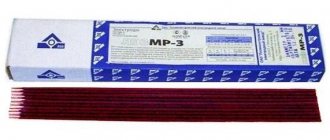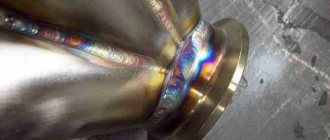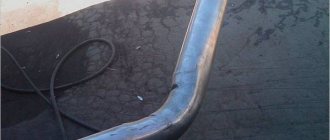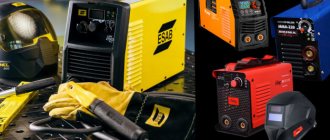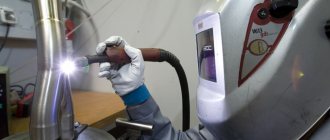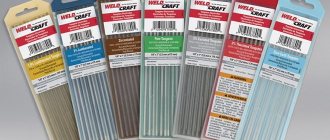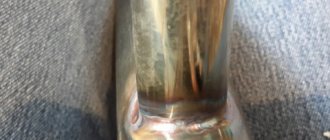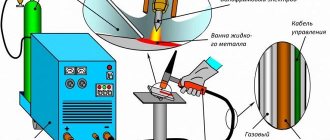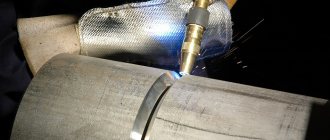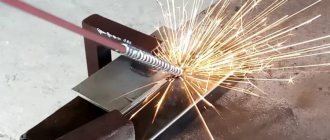Why is it important to use special electrodes for welding stainless steel?
Stainless steel, since its appearance on the metal market, has been widely used for the production of parts and assembly units that are used in various industries. The popularity of stainless steel is due not only to its resistance to corrosion, but also to a number of other properties. These include high strength parameters, appearance, and durability. But alloys of this class have one significant drawback - poor weldability. It must be said that this drawback significantly complicates working with stainless steel. This is due to a number of reasons, in particular:
- Stainless alloys have low thermal conductivity. This figure is two times less than that of traditional carbon steels. That is why, during welding work, this material is less able to remove excess heat generated during the work process. This phenomenon has led to the fact that in order to reduce heat, a welding current that is 15-20% less than that required for welding ferrous alloys is used.
- When joining stainless steel products with a large mass, a fairly large gap must be left between the workpieces. If this requirement is ignored, microscopic cracks will appear in the metal located next to the seam. Their presence will lead to a reduction in the quality of the connection, including its reliability.
- When welding stainless steel, a high electrical connection zone is formed in the weld area. Accordingly, this leads to strong heating of the tool. This is what determined that to perform welding work it is necessary to use special stainless steel consumables designed to work with such steels. They are selected based on the markings on the box or on the consumables themselves.
Equipment
When choosing equipment, welders do not make exceptions for stainless steel, since all work is performed using a welding inverter. There are models that are capable of performing high-quality work in domestic conditions. They are compact, powered from a household network (220 volts) and reliable.
A characteristic feature of the operation of any inverter is repeated voltage conversion. With this technology, the additive is fused into the metal more efficiently, and the seam is high-quality and smooth. Due to the fact that the prices for such devices are more than democratic, they have become accessible not only to industrial enterprises, but also to private craftsmen.
As noted above, stainless steel can be welded in the MIG or MMA mode, which means that any of the available inverters, even the simplest one, will do. It is important that the device allows precise adjustment of welding parameters, which directly depend on the thickness of the workpiece. Before work, you should treat the surface, clean it of dirt or oily substances.
It is known that when welding stainless steel, a gap must be maintained between the parts, otherwise cracks will form. When working with sheet metal whose thickness does not exceed 2 mm, no gap is needed. The edges of the parts are brought close to each other. If the thickness of the sheets exceeds 4 mm, then the edges are cut at an angle of 45° degrees, thus increasing the area of the penetration zone.
- When the metal thickness is 1.5 mm, electrodes with a diameter of 2 mm are used. The current strength is 40 - 60 A.
- Metal thickness – 3 mm, electrode diameter – 3 mm, current – 85 A.
- Metal thickness – 4 mm, electrode diameter – 3 mm, current – 100 A.
- Metal thickness – 6 mm, diameter – 4 mm, current – 150 A.
Stainless steel electrodes, what are their features?
When performing work with workpieces made from stainless steel, it is necessary not only to choose the right electrodes, but also to use welding equipment skillfully, in particular, to select the operating current, determine the gas flow, etc.
Electrodes for stainless steel welding
Violation of certain technological rules leads to such a phenomenon as intercrystalline corrosion. It reduces the corrosion resistance of the weld and adjacent metal. In addition, upon reaching a certain temperature, chromium and iron carbides begin to form in the structure. They make the metal excessively brittle and reduce its anti-corrosion characteristics.
Electrodes for stainless steel help to avoid this phenomenon, and if used correctly, the quality of the seam will meet all technical requirements.
Some welding work and difficulties
Below are some types of work that involve welding stainless steel, and an overview of the problems that may arise.
Pipe welding
A stainless steel pipe runs from the boiler to the expansion tank. Usually it is connected using an American pipe, however, if there is a complex pipe system, you will have to cook it a little, and you will have to do the welding itself to the boiler. Welder-plumber is a complex and extensive specialty that takes a long time to learn. You will have to weld in any position, and also think ahead about how to cut the pipe, in what sequence to weld the bend or perform other work.
Brew the muffler
Typically mufflers are made from ordinary steel. However, you can also buy stainless steel ones on sale. They perform well and last longer. During operation, the muffler is removed from the car, cleaned and repaired using patches. Thin-walled steel is placed on it, and cooking with an electrode here is pure masochism. Semi-automatic to the rescue.
Welding with inverter
Suitable for the same applications as DC welding. In this case, the polarity of switching on the holder is maintained. Typically, such welding will be slightly worse in quality than with a professional straightener. But if you consider that the rectifier weighs one hundred to two hundred kilograms, and the inverter weighs no more than twenty, then the choice will be in favor of the latter.
It is advisable to purchase an inverter that can be connected to a three-phase outlet. Two phases are usually not capable of providing such a current strength at which the metal will be well welded using similar methods.
Moreover, you should not include an inverter for welding stainless steel in the home network - eight-amp plugs are only enough for welding with ANO-24 electrodes. In general, working with the inverter is convenient; there is a system for auto-ignition and arc stabilization using automatic current regulation.
AC or DC
To create permanent connections from stainless steels, it is permissible to use direct and alternating current. Each welding technology has certain pros and cons.
Thus, the use of direct current leads to a reduction in the consumption of electrodes, due to the fact that when using this current, the material practically does not splash. In addition, direct current allows for high welding speed and quality of the weld. But the equipment used for the work is highly expensive, and this, as a result, leads to an increase in the cost of work.
The use of alternating voltage allows the use of equipment that costs significantly less than that used to generate direct current. A welder using alternating current results in a high-quality weld. But, at the same time, the use of alternating current leads to the production of more drops of metal, and this leads to increased consumption of stainless steel.
DC electrodes on stainless steel
Before starting welding work, the welder must make the correct choice of electrodes. It should be understood that coated rods can guarantee high quality seams. Manual welding is performed using direct current of reverse polarity. To obtain a high-quality result, welders use the following brands of consumables intended for stainless steel:
- TsL11 is one of the most widely used brands among welders. It is used for processing steels with a fairly high content of chromium and nickel. The weld produced using this material has high strength and impact toughness. There is virtually no metal spattering during operation.
- OZL8 - suitable for assembling structures subject to operation at temperatures up to 1000 ⁰C. Its remaining parameters are close to the TsL11 brand.
- NZH13 – this grade is in demand when processing food grade stainless steel products. In addition, this consumable is intended for joining products with a high content of chromium, nickel, and molybdenum. The disadvantage inherent in this brand is the formation of slag, which spontaneously flakes off and thus can cause damage to the worker or people around him.
OZL-8
In fact, in practical work, several brands of electrodes are used that are designed for welding with stainless steel. Among them are the following:
- ZIO-8, which is used for products made of heat-resistant stainless steels.
- NII-48G is in demand in the manufacture of critical structures.
- OZL-17U are suitable for parts that will be operated in an atmosphere with a high content of sulfuric or phosphoric acid vapors.
AC electrodes for stainless steel
Not all organizations can afford technological equipment that operates using direct current. But you can also use equipment that uses alternating voltage. To work effectively with it, the following brands are used: OZL-14, LEZ-8, TsT-50, EA-400, OZL-14A, N-48, ANV-36.
In addition, the use of tungsten rods for welding stainless steel parts under a cloud of protective gases allows the use of alternating current with straight polarity. This technology is used for:
- connecting parts with a thin wall;
- there are increased requirements for the quality of the weld.
OZL-14A
The practice of welding stainless steel products suggests that the use of alternating current is less popular, and accordingly, rods of this type are less in demand.
Useful tips
In order for welding of stainless steel parts to take place without any difficulties, during work you should take into account the recommendations from professionals:
- If during welding work the temperature rises to +500 degrees Celsius or higher, then it is quite possible that crystallization-type cracks will appear at the site of the future weld. This should not be allowed, otherwise the connection will be less strong and reliable.
- When welding stainless steel parts at temperatures from +350 to +500 degrees Celsius, the alloy becomes less ductile, and this can make the metal more brittle.
- To create a high-quality weld, stainless steel parts prepared for joining must be heated to a temperature of +1200 degrees, and then cooled naturally. They need to cool for at least 3 hours.
- The welding seam is as strong and reliable as possible when welding takes place in the shortest possible time. Prolonged heating of stainless steel products should be avoided. When using the layer-by-layer welding method, a new layer is applied only when the previous one has cooled to +100 degrees.
- Sometimes before applying the base layer you have to tack two blanks. In this case, you need to make sure that the gap between them is as small as possible. You should strive to ensure that the potholders are as long as possible.
Electrodes for stainless steels and ferrous metals
The combination of stainless steel and ferrous metal is quite possible. But this process is fraught with certain difficulties. The thing is that these metals have different structures. There are three methods you can use to perform this operation:
- welding using coated consumables;
- welding with non-consumable tungsten rods;
- welding under protective gas, as a rule, argon or gas mixtures based on it are used for this.
For welding dissimilar metals, the OZL-312 grade is used. To perform the assembly of critical structures, EA-395/9 is used. OZL-312 stainless steel welding rods are suitable for welding steels with an unidentified composition.
But, as practice shows, no one has come up with an optimal quality seam better than joining workpieces under gas protection. In this process, gas plays the role of protecting the weld pool from the effects of the atmosphere, in particular from nitrogen and oxygen. When welding with argon, there is one subtlety. To ensure the quality of welding, a welding rod is used, which must be held strictly at an angle of 90 ⁰ to the surfaces being processed.
Based on the above, we can draw the following conclusion: materials of wide application are used to perform welding of dissimilar metals.
Preparation for welding
The welding technology depends on the specialist who performs such work. Having selected the right electrode, you need to additionally prepare the future material for welding. First of all, this is degreasing the material.
The process of welding stainless steel at home and in special conditions differs in methods. When choosing it, you should rely on the main characteristics of the material, its thickness and strength. Gas welding is considered standard and can be used in almost any application. It can be performed in automatic, semi-automatic and manual mode. But there is one feature in which only electric arc is used - the thickness of the stainless steel sheet is more than three millimeters.
It is worth paying attention to this feature of welding stainless steel - you do not need to make sudden movements. Most often this is applicable during standard welding, but this should not be done with stainless material. This causes destruction of the created seam and oxidation. Such processes completely destroy the protective environment of the material itself and have a detrimental effect on the operation of the material. Additionally worth considering:
- Tungsten must not penetrate into the weld pool with the electrode. In this case, it makes no sense to talk about the reliability of the seam. To avoid its penetration, the arc should be ignited separately, on other graphite or carbon plastics;
- It is best to protect the seam from the reverse side with an argon jet. This requirement has become quite popular recently.
The main question of which electrode to use to cook stainless steel remains open. To create a truly high-quality seam you need to use:
- Electrode with high creep rates;
- Low thermal expansion rates;
- High wear resistance and thermal conductivity;
- Increased elasticity values
When choosing an electrode, the grade of stainless steel is decisive. Depending on its type, the popular brands listed above are used.
Welding stages
Only a professional should work with such material. This is a labor-intensive job that helps ensure that the joint resembles the base metal. To do this, carefully clean the welding areas using a degreaser (can be acetone or solvent).
An invector can be used as a welding machine. This device is convenient for transportation and is powered directly from the network. Under the influence of electricity, a welding arc is formed to weld the metal.
It is worth considering that the applicable temperatures should not be higher than normal. If you do not adhere to standard rules, the electrode may simply burn out or the seam will not be tight enough.
When welding, the main problem is that it has a fairly high resistance.
The peculiarity of electrodes is low heat conductivity.
This is considered one of the problems that causes their destruction. This happens because too much current is used. For maximum seam strength, the cold method is used. If the composition includes nickel or chromium, then it can be cooled with water. In other cases, an air blower or a copper gasket will work perfectly.
Before you start working, you should select stainless steel electrodes, and also set the current correctly. To prevent sticking from occurring, very carefully bring the electrode to the metal. The ground terminal is connected to the material, after which the arc begins to work. The electrode is brought at an angle and held for several seconds. The scale should be removed with a hammer and the surface should be sanded in circles. The finished product is placed in a bath with an acid solution. Only it can completely remove the oxide layer.
Electrodes for welding stainless steel 12Х18н10т
Steel 12Х18Н10Т is classified as an austenitic type material. This steel is widely used for the manufacture of equipment for the food and pharmaceutical industries.
Electrode welding
The following types of products are used to connect workpieces made of this steel:
- TsL-9, welding with its use can be performed in all spatial positions.
- OK 61.30, ensures weld quality and self-peeling of slag.
What electrodes should be used to cook 1 mm stainless steel?
One of the most difficult processes in welding processes is processing parts with thin walls. This is because:
- Excessive heat generated during welding can cause a hole to form.
- High temperatures may cause surface deformation.
- The electric arc, which is used when processing thin-walled parts, is small in size. Even a small separation of it from the surface of the workpieces being processed can lead to its disconnection.
Welding steel 1mm
All of the above difficulties significantly complicate the work of the welder. The correct choice of welding material can help eliminate these problems. For example:
- OK 63.34 - can be classified as universal electrodes; they can be used to work with workpieces of different thicknesses.
- OK 63.20 - they are used for processing pipes and thin-walled material.
Features of stainless steel
Unlike a number of other popular metals, stainless steel has a number of features that can appear when connecting elements from this metal. All this must be taken into account when starting to manufacture various structures and products from this material. Compared to many other types of steel, stainless steel has lower thermal conductivity. Because of this, you have to spend more time warming up the welding zone or use a higher current for work.
When welding elements of fairly large thickness made of stainless steel, the gap between them should be slightly larger than when connecting elements made of other types of steel. This is the only way to minimize the number of microcracks that may appear after welding.
When joining stainless steel elements by welding, the welding rods are heated to very high temperatures. This happens due to the fact that the metal has high resistance to welding processes. To reduce this manifestation, experts recommend using special electrodes designed for stainless steel for welding.
Popular electrodes for stainless steel welding
The most popular electrodes for stainless steel include those produced by the world's leading manufacturers. The use of branded products guarantees a high-quality weld.
ESAB
This Swedish company is a recognized leader in the development and manufacture of welding equipment and consumables used to work with various types of metals.
ESAB OK 61.30
Its enterprises produce brands such as:
- OK 61.35 - they are used for welding particularly critical structures, for example, pipelines operating under pressure.
- OK 67.72 - electrodes used for welding dissimilar metals.
TsL 11
Electrodes of this brand are used to work with such alloys as 09Х18Н12Т, 12Х18Н10Т, Х14Г14Н3Т and their analogues.
The key advantage of this consumable material is that the seam made with this electrode successfully resists intercrystalline corrosion.
MONOLITH
This is a domestic company that produces electrodes used for welding carbon and stainless steels.
Electrodes "Monolith"
Cost of electrodes
The price of stainless steel electrodes is determined by several factors, among which one of the main ones is the manufacturer. Among the types of consumables offered, the most affordable prices are electrodes designed for joining workpieces made of steel with low carbon content.
Among the products of foreign manufacturers, this requirement is met by electrodes of such brands as WT, ESAB, E3, WL. On the domestic market you can also find many worthy products that are not only more affordable, but also have all the characteristics of foreign electrodes - EHF, EVL, EVI , EVT.
Many different products and designs are made from stainless steel, although the process is quite complex. This is largely due to the low weldability of this metal. To ensure that this nuance manifests itself as little as possible not only during welding work, but also during the operation of the products, it is necessary to use electrodes suitable for this metal.
Each type of electrode that can be purchased on the market today is designed for welding a specific type of product , which must be taken into account when choosing this consumable. Professional welders are well aware of what electrode markings mean, but amateurs may have problems with this. Therefore, experts advise to study very carefully before purchasing all the characteristics of electrodes of a particular brand, so as not to later regret the low quality of the welding work performed.
